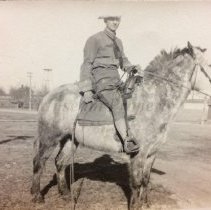Object Record
Images

Metadata
Object Name |
Print, Photographic |
Source |
Iowa Gold Star Military Museum |
Iowa History Era Tag |
Prosperity to the Depression (1897-1939) |
Chronological Tag |
The Emergence of Modern America (1890-1930) |
Catalog Number |
2018.043.006 |
Credit line |
Iowa Gold Star Military Museum - Johnston, Iowa |
Description |
This photograph depicts a US Cavalry soldier during World War One. He is stationed at Fort Des Moines. Fort Des Moines housed a number of US Cavalry Regiments up until around 1916. From there, many of these regiments were sent south to the US-Mexican Border. For any use other than instructional resources, please check with the organization that owns this item regarding copyright restrictions. |
Additional Research & Sources |
Fort Des Moines was built in 1843 at the intersection of the Des Moines and Raccoon River. Fort Des Moines established itself as an important military base that played a major role in the Civil War and both world wars. The facility was vacated in 1846. In 1901, Fort Des Moines was revived as the Fort Des Moines Provisional Army Officer Training School located on the south side of Des Moines. It became the only training site for African American officers in the nation. During the early 1900s, the fort housed the 25th Infantry Prison Guard, as well as the 11th, 2nd, and 6th US Cavalry Regiments. In 1916, these Cavalry Regiments left for service at the Mexican border. In their place, the camp trained 1,250 African American men, all who had college degrees, to become US military officers. These men were paid seventy five dollars in gold coin. A white officer, Lieutenant Colonel Charles C. Ballou, commanded all of the African American soldiers at Fort Des Moines. These men would eventually be sent to Europe to fight in the First World War. (Iptv.org) The fort would play a major role in World War II as well. In 1942 the Army opened an officer training school for women at Fort Des Moines. During World War II, Fort Des Moines served as a military training center for the Women’s Army Auxiliary Corps (WAAC), later renamed the Women’s Army Corps (WAC). The fort, as well as other neighboring facilities, started with 11,000 new female recruits and successfully trained 72,141 women including a small contingent of African American female officers. After the war, Fort Des Moines became a separation center for the WAC. (Schwieder, 280-281) Eventually the fort would become a post for the US Army Reserve. The fort also became a National Historic Landmark in 1974. During the Vietnam War, Fort Des Moines would become the location of the Des Moines Armed Forces Examining and Entrance Station. The fort closed its doors in 2008. (Militarybases.com) Today, the buildings serve as a Correctional facility, as well as apartment buildings. There is also a Fort Des Moines Museum and Education Center. IPTV Resource on Fort Des Moines: Click Here This object connects to the following standards: Standard SS.4.25 Technological Change: A lesson could be created on how Fort Des Moines has changed since its establishment in 1843. |
Primary/Secondary Source |
Significant - Local |
County Tag |
Polk |
Multimedia Links |
Click here to view/hear the file. |
Search Terms |
Des Moines Iowa Military camps Military facilities Military organizations Military training U.S. Army War War & Conflict |
Legal Status |
Ownership of this resource is held by the Iowa Gold Star Military Museum and has been provided here for educational purposes only, specifically for use in the Iowa Museum Association's "Teaching Iowa History" project. It may not be downloaded, reproduced or distributed in any format without written permission from the Rights Holder. For information on U.S. and International copyright laws, consult an attorney. |
